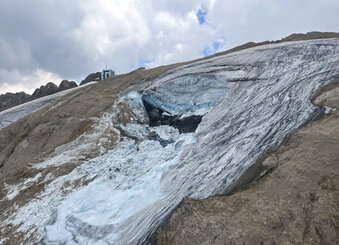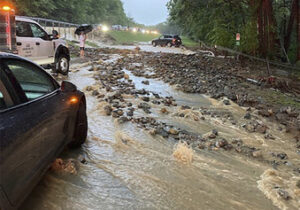Rain hampers search for missing in Italian glacier avalanche
4 min read
This undated image made available Monday, July 4, 2022, by the press office of the Autonomous Province of Trento shows the glacier in the Marmolada range of Italy's Alps near Trento from which a large chunk has broken loose Sunday, killing at least six hikers and injuring eight others. Drones were being used to spot any more bodies on an Italian Alpine mountainside a day after a huge chunk of a glacier broke loose, sending an avalanche of ice, snow, and rocks onto hikers. Rescuers on Sunday spotted six bodies and said nine survivors were injured. Attention on Monday was focused on determining how many people who might have been hiking on the Marmolada peak are unaccounted for. Rescuers said conditions downslope from the glacier, which has been melting for decades, were still too unstable to immediately send rescuers and dogs into the area to look for others buried under tons of debris. (Autonomous Province of Trento via AP)
ROME (AP) — Thunderstorms hampered Monday the search for more than a dozen hikers who remained unaccounted for a day after a huge chunk of an Alpine glacier in Italy broke off, sending an avalanche of ice, snow and rocks down the slope. Italy’s state TV said another body was recovered, raising the known death toll to seven.
Nine others were injured when the avalanche was unleashed from the Marmolada glacier Sunday afternoon when dozens of hikers were on excursions, some of them roped together.
Trento Prosecutor Sandro Raimondi said 17 hikers were initially believed to be missing, the Italian news agency LaPresse reported. But later, RAI state TV reported from the scene that the number of unaccounted for dropped to 15 after authorities were able to track down some of those feared missing.
The detached ice block was massive, estimated at 200 meters (yards) wide, 80 meters tall and 60 meters deep. Gov. Luca Zaia, whose Veneto region in northeast Italy borders the Marmolada area, likened the avalanche to an “”apartment building (sized) block of ice with debris and Cyclopean masses of rock.”
”I can’t say anything else other than the facts, and the facts tell us that the high temperatures don’t favor these situations,” Zaia told reporters.
Italy is in the grips of a weeks-long heat wave, and Alpine rescuers said that the temperature at the glacier’s altitude last week topped 10 C (50F) when usually it should over around freezing at this time of year.
An ice rink in the Dolomite mountain resort town of Canazei was serving as a makeshift morgue to identify dead, a task made more challenging and gruesome because rescuers said in some cases body parts were found strewn over a wide area.
At least four bodies brought to the ice rink had been identified by Monday afternoon.
RAI said three of those identified were Italians, including an experienced Alpine guide who was leading a group of hikers. Another was a hiker whose relatives said he had just sent a selfie of himself from the slope shortly before the avalanche barreled down.
One of the dead was from Czechia, RAI said.
According to media reports, those feared missing include some Italians three Romanians, one with French nationality, another from Austria, and four from Czechia.
Some of those hiking in the area on Sunday were roped together as they climbed.
Raimondi was quoted as saying two of the injured are Germans. Zaia told reporters that one of the Germans was a 65-year-old man. Of the patients was so badly injured, so far identification has been impossible.
The hospital survivors suffered chest and cranial injuries, said Zaia.
Drones were being used to help look for any of the missing as well as verify safety.
Sixteen cars remained unclaimed in the area’s parking lot, and authorities sought to track down occupants through license plates. It was unclear how many of the cars might have belonged to the already identified victims or to the injured, all of whom were flown by helicopters on Sunday to hospitals.
The thunderstorm forced the helicopter flying Premier Mario Draghi to the stricken area to be diverted.
What caused a pinnacle of the glacier to break off and thunder down the slope at a speed estimated by experts at some 300 kph (nearly 200 mph), wasn’t immediately known.
But high temperatures were widely cited as a likely factor.
Jacopo Gabrieli, a polar sciences researcher at Italy’s state-run CNR research center, noted that the long heat wave, spanning May and June, was the hottest in northern Italy in that period for nearly 20 years.
“It’s absolutely an anomaly,” Gabrieli said in an interview on Italian state TV Monday. Like other experts, he said it would have been impossible to predict when or if a serac — a pinnacle from a glacier’s overhang — could break off, as it did on Sunday.
Operators of rustic shelters along the mountainside said temperatures at the 2,000-meter (6,600 foot) level recently reached 24C (75 F) – unheard of in a place where excursionists go in summer to keep cool.
The glacier, in the Marmolada range, is the largest in the Dolomite mountains in northeastern Italy. People ski on it in the winter. But the glacier has been rapidly melting away over the past decades, with much of its volume gone. Experts at Italy’s state-run CNR research center, which has a polar sciences institute, estimated a couple of years ago that the glacier will disappear within 25-30 years.
The Mediterranean basin, which includes southern European countries like Italy, has been identified by U.N. experts as a “climate change hot spot,” likely to suffer heat waves and water shortages, among other consequences.
Pope Francis, who has made care of the planet a priority of his papacy, tweeted an invitation to pray for the avalanche victims and their families. “The tragedies that we are experiencing with climate change must push us to urgently search for new ways that are respectful of persons and nature,” Francis wrote.






